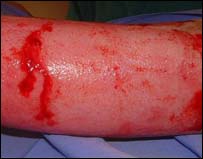Skin regeneration from genetically modified cells
Scientists at the University of Cincinnati, USA have successfully created skin against pathogens to regenerate the skin of severely burned patients by transplanting transgenic cells into alternative skin.

Damaged cells or transgenic burns will be able to protect against infection and not be affected by antibiotics.(Photo of BBC)
In the laboratory, genetically engineered skin cells kill more positive bacteria than normal skin. Burns are a favorable environment for bacteria to grow because damaged skin is no longer able to protect itself.
Usually, burns are applied and kept clean to help prevent infection.
Now, by using genetically modified skin cells, it is possible to actively reduce the likelihood of infection, improve graft tissue regeneration and reduce the dependence of antibiotics.
During the study, the scientists discovered genetically engineered skin cells that produced a high-level HND4 protein capable of killing many types of bacteria compared to normal skin cells. .
HBD4 protein is one of the proteins that exists in the body as part of the immune system. Scientists believe that transplanting transgenic skin cells into grafted skin will create an increase in the immune system.
BS.Dorothy Supp if this therapy successfully tested on people opens a new direction for infection control treatment with promising choices for burns.
In addition, less dependence on antiviral drugs is also one of the methods to minimize emergency patients with antibiotic-resistant viruses.
Because transplanted skin tissue is not connected to the blood circulation system during transplantation, they should not be exposed to antibiotics being infused into the body or antibiotics from the immune system. of the body against infection.
mystical gem
- The Japanese laboratory almost snapped the genetically modified mice
- Genetically modified plants still cause doubts
- Genetically modified food in Vietnam ever since?
- Genetically modified salmon in the US is controversial
- Cure skin cancer with genetically modified viruses
- Things you should know about GMO genetically modified foods
- Genetically modified insects threaten genetically modified plants
- Using genetically modified foods is prone to cancer
- He called on the EU to approve genetically modified corn by voting
- Legislation of genetically modified corn harmful
- Skin cells help fight cancer in children
- Countering genetically modified corn causes cancer in mice
 Green tea cleans teeth better than mouthwash?
Green tea cleans teeth better than mouthwash? Death kiss: This is why you should not let anyone kiss your baby's lips
Death kiss: This is why you should not let anyone kiss your baby's lips What is salmonellosis?
What is salmonellosis? Caution should be exercised when using aloe vera through eating and drinking
Caution should be exercised when using aloe vera through eating and drinking Doctors warn about the 'secret' of soaking your face in ice water to stay young
Doctors warn about the 'secret' of soaking your face in ice water to stay young  'Unexpected' source of nutrients from the peels of many vegetables and fruits
'Unexpected' source of nutrients from the peels of many vegetables and fruits  From 'monster' to 'treasure': This horror species is helping many people make a fortune
From 'monster' to 'treasure': This horror species is helping many people make a fortune  How are freckles different from melasma?
How are freckles different from melasma?  Discovery of dinosaur fossils with feathers and scales
Discovery of dinosaur fossils with feathers and scales  The world has only recorded 100 cases of women with skin diseases
The world has only recorded 100 cases of women with skin diseases 